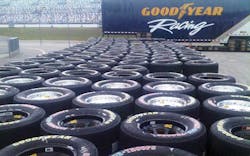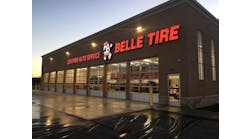Any NASCAR fan knows. What’s the official tire of NASCAR? Goodyear. And it will remain that way at least for the next five years. In October 2011, Goodyear and NASCAR signed an extended agreement for Goodyear to continue as the exclusive tire used in NASCAR’s top three racing series for the next five years.
That’s good news for the Goodyear Tire & Rubber Co. But it’s also good news for any dealer who sells Goodyear’s G3 tires — Goodyear, Dunlop and Kelly.
“If we compare your average consumer versus somebody that identifies himself as a NASCAR fan, we get a lift in market share,” says Kris Kienzl, Goodyear’s NASCAR marketing manager. “NASCAR fans come in to buy Goodyear tires, versus the average consumer.”
As the official tire of NASCAR, the Goodyear tire brand is exclusive for NASCAR’s top three series — the NASCAR Sprint Cup Series, the NASCAR Nationwide Series and the NASCAR Camping World Cup Series.
“We have a lot of operational commitment as the official tire,” says Kienzl. “We have a large group of racing engineers. They’re not only in Akron, Ohio, working on developing tires for NASCAR; they follow them to the track. They work with the teams and get a lot of data. They get a lot of feedback so they can continuously use that information in future development.”
Goodyear doesn’t release specific numbers on how much the company spends to be the official tire of NASCAR. However, it is a significant investment. Kienzl says the company’s market share data and sales volume figures do support the investment.
It looks like the relationship is paying off. According to the 2011 Modern Tire Dealer Facts Issue, the top brand in the U.S. consumer tire market in 2010 was Goodyear, with 17.6% of an industry total of 226.3 million units (Bridgestone was second at 17.3%, followed by Michelin at 16.8%). Goodyear also has the highest percentages of the U.S. replacement consumer tire brand shares. Goodyear has 15% of passenger tires (based on 198.7 million units) and 12.5% of light truck tires (based on 27.6 million units).
Track to street
Better sales are only part of Goodyear’s motorsports marketing strategy. Consumers benefit as well. How? Track to street technology transfer. Kienzl explains that being involved in motorsports helps the company design better tires for consumers.
“Our tires are endemic and are used in the sport versus being a sponsor in the NFL, where we would just be a name,” says Kienzl.
“The development that our engineers do with NAS-CAR tires really trickles through all of our company. There’s a lot of learning week-in and week-out as far as thinking about new technologies, bringing new technologies to market and taking some of those technologies from racing tires and transferring them over to consumer tires.”
According to Jim Davis, Goodyear’s public relations manager, many of the technologies that Goodyear uses in consumer products were first developed for racing. This includes various tires reinforced with carbon fiber (the ultra-high performance Eagle ResponsEdge, for example) and DuPont Kevlar (the off-road Wrangler MT/R, for example).
In addition, a Goodyear innovation that crossed over from racing to street tires is run-flat technology. In 1966, Goodyear developed an inner-liner for race tires to prevent race cars from decreased control after a sudden loss in tire pressure. The offspring of that was Goodyear’s RunOnFlat Technology used in some consumer tires.
Track to street technology transfer isn’t the only advantage for Goodyear. The tech transfer also goes from street to track.
“Goodyear developed a new rain tire for possible use in the NASCAR Nationwide Series,” explains Davis. “The tire could be used in wet track conditions at some road courses on the NASCAR Nationwide Series schedule. The race tire’s tread pattern is similar to that featured on the Goodyear Eagle F1 all-season high-performance tire for consumer use.”
[PAGEBREAK]
Marketing the NASCAR brand
Kienzl says NASCAR is the second-most popular sport on television in the United States. That’s a huge opportunity to reach a broad base of consumers. But NASCAR fans are no ordinary consumers.
“NASCAR fans are interested in technology,” says Kienzl. “They tend to know a little more about cars. Their neighbors ask them for advice about cars and tires. From a marketing perspective, we want to grow Goodyear brand affinity and purchase intent — and market share in the end. Our research shows that NASCAR fans are very brand-loyal.”
Goodyear’s research also reveals that NASCAR brand loyalty benefits dealers.
When a NASCAR fan is shopping for tires and deciding what brand they intend to purchase, they are more likely than the average consumer to walk into a store with the Goodyear brand in mind. And, they don’t change their mind once they enter the store.
“That is very positive for Goodyear when they’re coming in predisposed to buy our brand,” says Kienzl. “It may be up to the guy behind the counter to help them with which Goodyear tire is right for them, but they are coming in predisposed because they want our brand. That is a good thing for our dealers selling Goodyear tires.”
Kienzl says that Goodyear’s team of sales representatives around the country run sales incentives for Goodyear dealers. If a dealer wants to run a special NASCAR promotion, the company will help them with ideas and provide them with promotional materials. They can provide dealers with NASCAR race tickets, garage passes and hospitality suite access.
“We have taken dealers on NASCAR garage tours and provided them with information about what Goodyear does at the track,” Kienzl explains. “Just reinforcing that knowledge helps better educate the people who are selling the tires.”
Another way Goodyear educates dealers and consumers is through national marketing campaigns.
The company launched its “More Driven” campaign earlier this year. Kienzl says the whole idea behind the campaign is that more experts choose Goodyear for its superior performance.
“The More Driven campaign absolutely has NASCAR integrated into it,” Kienzl says. “With our dealers, the more we integrate NASCAR and Goodyear brand loyalty, it will naturally trickle down to Goodyear dealers.”
Trackside tires
The Goodyear Tire & Rubber Co. delivers all the tires required for every NASCAR race weekend. That includes not only the tires that will be used during the actual race, but also the tires NASCAR teams will need for testing, practice and qualifying.
NASCAR rules require teams to lease the tires from Goodyear, so they don’t own them.
“We used to sell the tires to the teams,” explains Kris Kienzl, Goodyear’s NASCAR marketing manager. “What would happen is you’d have a team with a lot of sponsor money like a Hendrick Motorsports. They would be able to buy tires and then go out and do their own testing and become even stronger. Then they’d get on the track and you’d have them versus a one-car team that just couldn’t afford to do their own testing. So NASCAR asked us to put together a leasing program to even-out the playing field.”
To further even-out the field, NASCAR also changed the rules to limit teams from performing their own tire tests. Today NASCAR teams, big and small, are more evenly matched.
NASCAR teams lease the tires from Goodyear at what Kienzl calls “the low, low price of $449 a tire.” After a tire is used, it is returned to Goodyear. What would happen if someone didn’t want to return a tire? NASCAR and Goodyear have a unique method of ensuring that all tires are returned.
“We actually have radio frequency identification (RFID) chips in those tires for tracking,” says Kienzl. “We check them out and check them in. So teams can’t leave — their hauler can’t drive away — until all the tires have been returned after the race. It’s a process that works very well and we’ve never lost a tire.”
Teams also are not allowed to keep the tires that are on the car when the race finishes. Goodyear provides temporary tires that are installed on each stock car so teams can put the vehicle back in the hauler. So what happens to all those used tires after the teams go home?
“We drill holes in the sides of them,” Kienzl reveals. “If anything were to happen to the tire — somehow somebody got their hands on one — it would be rendered useless.”



